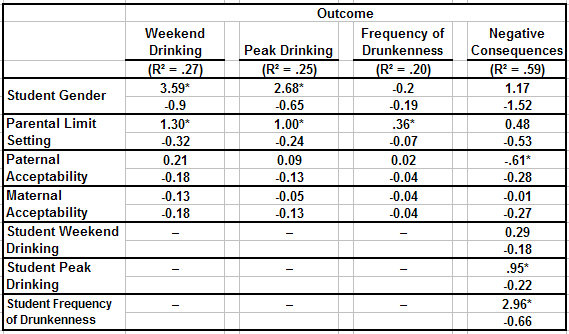The DRAM, Vol. 5(6) – High school limits and college drinking: Parental influence on college students’ alcohol use
Research indicates that alcohol abuse is linked to negative consequences (e.g., drunk driving, physical altercations, etc.) among college students (Hingson, Heeren, Winter, & Wechsler, 2005). Although previous research has shown that parental influence diminishes when adolescents enter college, more recent research suggests that parents still have some influence (Galotti & Mark, 1994; Lehr, Dilorio, Dudley, & Lipana, 2000). This week the DRAM reviews a study that examined the impact of parental permissibility of alcohol use during late high school on alcohol use and negative drinking consequences experienced among college students (Abar, Abar, & Turrisi, 2009).
Methods:
- The researchers randomly recruited 500 freshmen college students from a northeastern university to complete an online survey assessing their parent-teen communication and alcohol use behaviors.
- Participants (N=290, 58% response rate) were at least 18 years of age, were 61% female and 88.9% Caucasian; 97.2% lived in dormitories.
- The survey consisted of demographics and questions designed to measure:
- parent permissibility of alcohol (i.e., student report of parent limit setting in high school and maternal and paternal acceptance of alcohol);
- student drinking behavior (i.e., weekend drinking, peak drinking, and frequency of being drunk in the past month); and
- negative consequences of alcohol within the last year (26 items from the Young Adult Alcohol Problem Screening Test; Hurlbut & Sher, 1992).
Results:

Figure. Parent permissibility and students’ drinking behavior and negative consequences – unstandardized B weights and SEs (adapted from Abar et al., 2009). Click image to enlarge.
*p < .001. Note. These weights reflect a saturated structural equation model that also included other family variables, none of which contributed significantly. For student gender, 1=male and 0=female. For parental limit setting, a high score indicates permissive limits. Click image to enlarge.
- Students reported consuming an average of 9.14 drinks per weekend (SD=7.98), an average peak of 7.04 drinks (SD=5.77) on one occasion, being drunk an average of 1.86 (SD=1.65) times, and experiencing an average 18.90 (SD=16.44) negative consequences from alcohol in the past month.
- Parent permissibility was predictive of college drinking behaviors (see Figure).
- Permissive parental limits for alcohol use in high school were associated with greater college drinking but not negative consequences.
- Higher paternal acceptability of alcohol use in high school was associated with fewer negative consequences of college drinking.
- Separate analyses found that students whose parents had allowed no drinking during high school reported less college drinking (M diff weekend drinks = -4.99, t (254) = -5.14, p<.001; M diff peak drinks = -3.56, t (256) = -5.10, p<.001; M diff frequency of drunkenness = -1.08, t (256) = -5.51, p<.001) and experienced fewer negative consequences (M diff= -10.10, t (256) = -5.03, p<.001) than their college peers.
Limitations:
- The study used self-report and retrospective data.
- Parental variables reflected student perceptions of parent behavior.
Conclusion:
This study does not support the theory that allowing adolescents to experiment with drinking will lead to a later reduction in alcohol misuse. Instead, the study indicates that having parents who allowed any drinking during high school was a significant risk factor for alcohol misuse during college. The size of those limits, if greater than zero, did not affect negative consequences, and paternal acceptance of alcohol use had a negative effect on consequences, suggesting that among students whose parents allowed some drinking in high school, the relationship between parent permissiveness and alcohol misuse is more complicated.
— Tasha Chandler
What do you think? Please use the comment link below to provide feedback on this article.
References:
Abar, C., Abar, B., & Turrisi, R. (2009). The impact of parental modeling and permissibility on alcohol use and experienced negative drinking consequences in college. Addictive Behaviors, 34(6-7), 542-547.
Galotti, K. M., & Mark, M. C. (1994). How do high school students structure an important life decision? A short term longitudinal study of the college decision-making process. Research in Higher Education, 35, 589-607.
Hingson, R., Heeren, T., Winter, M., & Wechsler, H. (2005). Magnitude of alcohol-related mortality and morbidity among U.S. college students ages 18-24: Changes from 1998 to 2001. Annual Review of Public Health, 26, 259-279.
Hurlbut, S. C., & Sher, K. J. (1992). Assessing alcohol problems in college students. Journal of American College Health, 41(2), 49-58.
Lehr, S. T., Dilorio, C., Dudley, W. N., & Lipana, J. (2000). The relationship between parent-adolescent communication and safer sex behaviors in college students. Journal of Family Nursing, 6, 180-196.